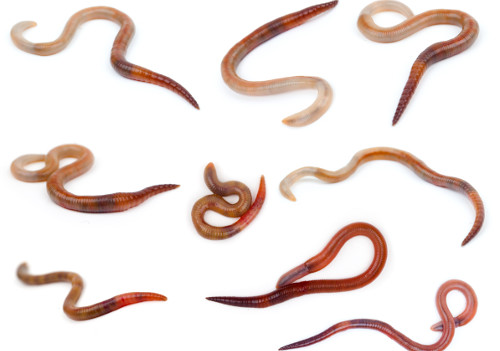Organic Composting with Red Wiggler Worms - Boost Your Yard's Development
Organic Composting with Red Wiggler Worms - Boost Your Yard's Development
Blog Article
Red Wiggler Worms Demystified: Opening the Keys of Vermiculture for Greener Living and Nutrient-Rich Soil
In the realm of sustainable methods for enhancing soil top quality and advertising eco-conscious living, red wiggler worms play a crucial yet often ignored function. Red Wiggler Worms. Comprehending the details of caring for these worms, maximizing their setting, and harnessing their castings can lead to a greener lifestyle and much healthier dirt for plants to thrive.
The Duty of Red Wiggler Worms
Red Wiggler worms play a vital function in composting systems by effectively breaking down raw material into nutrient-rich castings. These starved eaters take in a variety of natural products, such as kitchen scraps, backyard waste, and paper items. As they feed, the worms' digestive system processes damage down the organic matter right into a fine, dark, and nutrient-dense product understood as worm castings or vermicompost.
The castings generated by Red Wiggler worms are very beneficial for soil health and wellness and plant development. They are rich in necessary nutrients like nitrogen, potassium, and phosphorus, which are vital for sustaining healthy and balanced plant growth. Furthermore, worm castings contain helpful microorganisms and enzymes that help improve soil framework, increase water retention, and improve nutrient uptake by plants.
Benefits of Vermicomposting

Furthermore, vermicompost, the nutrient-rich end product of vermicomposting, acts as a superb natural fertilizer and soil conditioner. It improves soil structure, enhances soil oygenation, and enhances dirt moisture retention. These residential properties contribute to healthier plants with more powerful origin systems and better resistance to conditions and pests. Vermicompost additionally enhances the soil with essential nutrients like potassium, nitrogen, and phosphorus, advertising plant development and general soil fertility.
Furthermore, vermicomposting assistances sustainable gardening methods by giving a natural and chemical-free option to artificial fertilizers. Red Wiggler Worms. This eco-friendly method not only improves the soil yet also assists lower dependence on unsafe chemicals, promoting a greener and extra sustainable means of gardening
Establishing a Worm Container
When establishing a worm container for vermicomposting, correct setup is essential to guarantee the success of the composting process. The initial step in setting up a worm container is choosing an appropriate container.
After adding the bed linen, present the red wiggler worms to the container. It is advised to begin with a little number of worms and slowly increase as they multiply. The worms should then be offered with food scraps such as vegetables and fruit peels, coffee grounds, and eggshells. It is necessary to stay clear of including meat, dairy products, oily, or salty foods to stop attracting parasites and developing unpleasant odors.
Frequently keep an eye on the useful content dampness degrees and temperature in the worm bin to make sure optimum problems for the worms. With proper configuration and maintenance, the worm bin will effectively convert natural waste into nutrient-rich compost for your plants and yard.
Collecting Worm Spreadings
To effectively accumulate nutrient-rich worm spreadings from your vermicomposting system, a methodical harvesting method is necessary. When it comes time to collect the worm castings, there are a couple of key steps to comply with to make sure an effective procedure. To start with, stop including fresh food scraps to one side of the worm container for a number of weeks prior to harvesting. This motivates the worms to migrate sideways with fresh bed linens and food, making it simpler to dig the castings from the other side.

Troubleshooting Common Issues
Recognizing and dealing with usual challenges that might occur throughout the vermicomposting process is critical for keeping a effective and healthy and balanced worm bin. One typical issue that vermicomposters experience is overfeeding. Including excess food scraps can result in an accumulation of moisture and acidity in the worm bin, possibly damaging the worms. To avoid this, feed the worms in moderation, making sure that the food scraps are effectively damaged down before adding a lot more. One more problem is unpleasant smells originating from the worm bin. Foul smells show anaerobic problems, generally triggered by overwatering or insufficient air flow. To correct this, adjust the dampness degrees by including dry bed linens materials like shredded paper or cardboard and boost oygenation by transforming the bed linen on a regular basis.
In addition, if the worm population is decreasing or the worms show up undesirable, maybe as a result of environmental stressors such as extreme temperature levels or pH degrees. Checking these elements and making necessary adjustments is important for the wellness of the worms. By fixing these usual issues immediately, vermicomposters can make sure a smooth and effective vermicomposting procedure while maintaining a flourishing worm populace.

Verdict
In final thought, red wiggler worms play an essential function in vermiculture by damaging down natural matter into nutrient-rich dirt. Establishing up a worm bin is necessary for successful vermiculture, and harvesting worm castings gives beneficial garden compost for gardening.
As they feed, the worms' gastrointestinal procedures damage down the natural issue into a penalty, dark, and nutrient-dense product known as worm castings or vermicompost.
The spreadings produced by Red Wiggler worms are very beneficial for dirt health and wellness and plant growth. Adding excess food scraps can lead to an accumulation of wetness and level of acidity in the worm bin, potentially damaging the worms.Additionally, if the worm image source populace is decreasing or the worms appear unhealthy, it could be due to ecological stress factors such as extreme temperature levels or pH degrees. Setting up a worm container is important for successful vermiculture, and collecting worm castings supplies important garden compost for horticulture.
Report this page